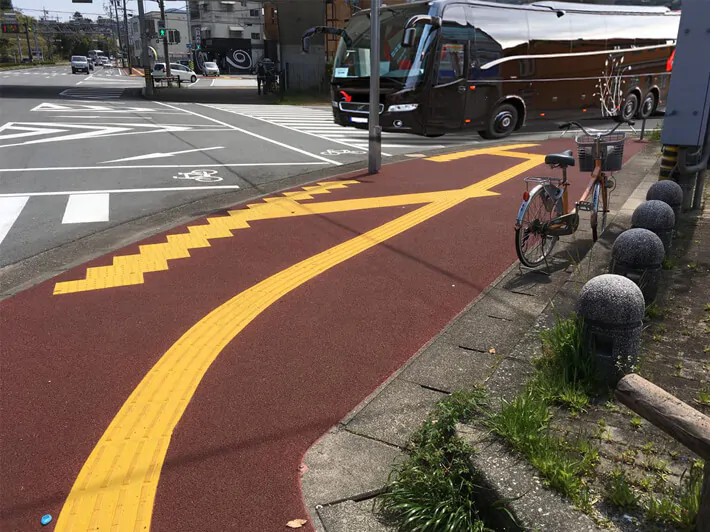
Improving sidewalks by installing tactile Indicator to make cities accessible for visually impaired people
Imagine walking through your city with your eyes closed.
You step out of your home, cross busy intersections, avoid obstacles, navigate stairs, board a train—and you do it all without relying on sight. Now, imagine doing this every single day. For over 253 million people worldwide living with visual impairment, this is a daily challenge.
Urban environments are designed with visual cues—traffic lights, signs, road markings—but what about those who can’t see them?
What Are Tactile Indicators?
Tactile indicators are specially designed surface features that are detectable underfoot or by a white cane. These indicators provide essential information such as direction, warnings, and changes in path or elevation. Installed in public pathways, they help visually impaired pedestrians safely navigate complex urban layouts.
1. Warning Tactile Indicators
Also known as hazard tactiles or decision indicators, these consist of a grid of raised domes or studs. Their purpose is to alert the user to potential hazards ahead—such as stairs, ramps, railway platforms, or street crossings. They don’t define what the hazard is but warn the user to stop and assess their surroundings.
2. Directional Tactile Indicators
Also referred to as leading tactiles, these are rows of raised bars aligned in the direction of travel. They guide users along safe paths and help them navigate around urban elements like benches, bollards, or street furniture.
The Importance of Sidewalk Design in Urban Mobility
Sidewalks are not just walking paths—they are lifelines of urban transportation. Unfortunately, many are still designed without inclusivity in mind. Crosswalks without curb cuts, unmarked steps, or shared surfaces with cyclists and vehicles can pose serious risks.
Inclusive sidewalk design must serve everyone—children, elderly citizens, parents with strollers, wheelchair users, and visually impaired pedestrians alike. This means incorporating:
-
Detectable warning surfaces at transitions
-
Tactile paving blocks at intersections and hazard zones
-
Directional tactile paths for continuous navigation
-
Bollards to define boundaries and mark pedestrian zones
Positional Tactile Blocks: A New Layer of Safety
In some advanced urban designs, positional tactile blocks are used in combination with directional and warning tactiles. These blocks help users understand where they are—such as the center of a platform, waiting area, or boarding zone—by providing a unique texture or pattern that signals a location-specific cue.
Though not yet standardized globally, positional tactile blocks are emerging as an effective tool in smart city designs.
Practical Tips for Making Outdoor Spaces Accessible
Urban planners, designers, and contractors must consider practical steps when creating accessible public spaces:
- Place tactile paving at the edge of sidewalks, stairs, ramps, and pedestrian crossings
- Use directional tactiles to lead users through complex environments like transport hubs
- Clearly define boundaries using bollards or color-contrasted surfaces
- Expand curb cuts and remove uneven transitions in crosswalks
- Integrate tactile cues where trees, benches, or structures interrupt walking paths
Your Trusted Partner in Tactile Safety: Eminent Tactiles
If you’re unsure which tactile indicators are suitable for your space, Eminent Tactiles is here to help. As one of India’s most reliable manufacturers and exporters of tactile products, we provide end-to-end services—from planning to installation.
Our range includes:
-
Civic Edge Protectors
-
Civic Anti-skate Studs
-
And even emerging solutions like positional tactile blocks
Let’s Build Safer, More Inclusive Cities Together
Installing tactile indicators isn’t just about following regulations—it’s a commitment to creating spaces that respect dignity, accessibility, and equality. Every sidewalk, crossing, and transit hub designed with care helps remove barriers for people with visual impairments.
Is your public space ready to be truly inclusive?
Partner with us to bring safety, independence, and accessibility to the forefront of urban design. Together, we can create cities that are not only smart but compassionate, designed for everyone, seen and unseen.
Tactile indicators, also called Tactile Ground Surface Indicators (TGSI), are raised patterns or surfaces installed on sidewalks, crossings, and public areas. They provide underfoot or cane-detectable cues, helping visually impaired people navigate safely by signaling hazards, direction, and positional information.
Tactile paving improves safety, independence, and mobility for visually impaired individuals. It alerts users to obstacles, stairs, ramps, intersections, and pedestrian zones, making urban spaces more inclusive.
Warning Tactiles: Raised domes or studs to indicate hazards like stairs, ramps, or crosswalks.
Directional Tactiles: Raised bars guiding pedestrians along safe paths.
Positional Tactile Blocks: Unique textures that indicate specific locations like platform centers or waiting areas.
Yes. Many countries follow standards like the ADA (Americans with Disabilities Act) or local accessibility guidelines that require tactile indicators at public crossings, sidewalks, transport hubs, and hazard zones.
They should be installed at staircases, ramps, pedestrian crossings, edges of sidewalks, intersections, hazards, transit hubs, and areas with obstacles like benches, bollards, or trees.
Eminent Tactiles is a trusted tactile indicators manufacturer and exporter in India, offering a wide range of tactile products, including warning tactiles, directional tactiles, civic road studs, edge protectors, and anti-skate studs.
- Improving sidewalks by installing tactile Indicator to make cities accessible for visually impaired people
- The Urgent Need for Inclusive Urban Navigation
- What Are Tactile Indicators?
- The Importance of Sidewalk Design in Urban Mobility
- Positional Tactile Blocks: A New Layer of Safety
- Practical Tips for Making Outdoor Spaces Accessible
- Your Trusted Partner in Tactile Safety: Eminent Tactiles
- Let’s Build Safer, More Inclusive Cities Together

offer now at
Our Clients





































